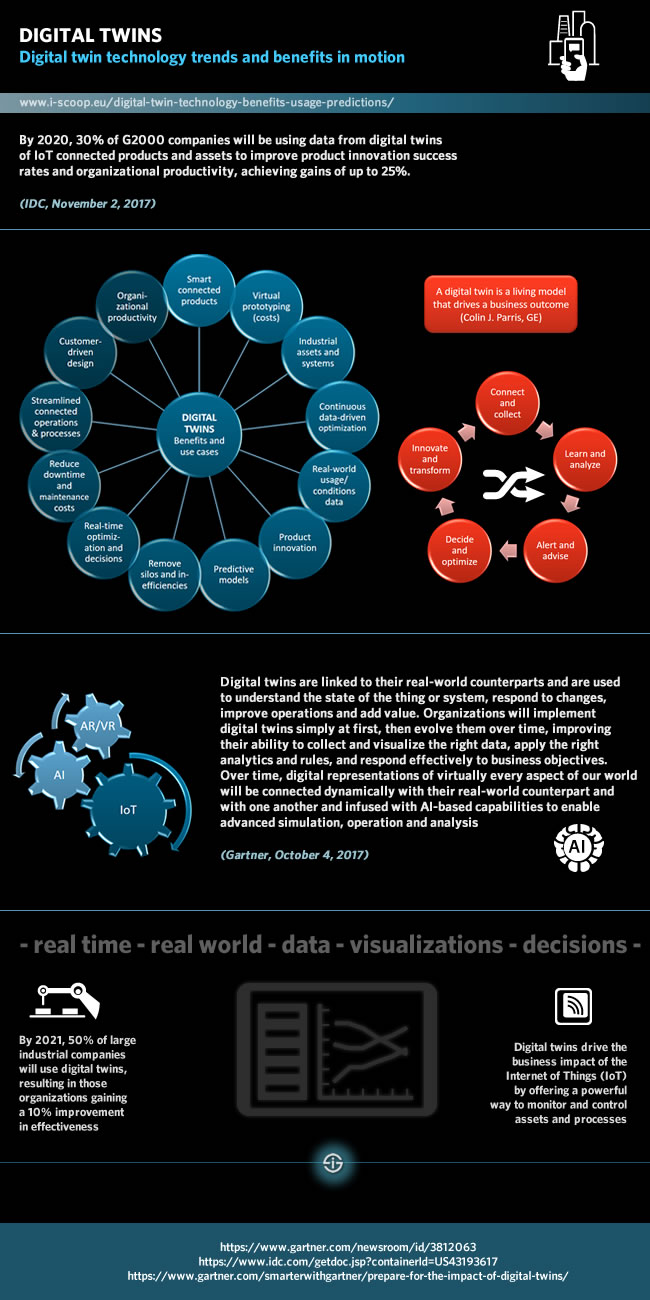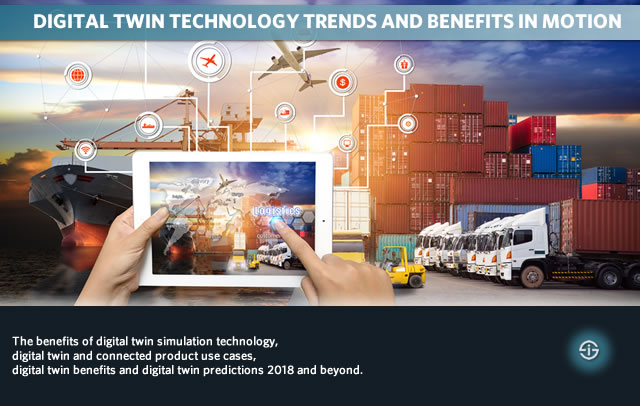As written previously digital twins are dynamic digital or virtual software replications of physical assets, products and constructions. Which asset, product or construct, from cars and motor cycles to engines, wind turbines and even buildings, spacecrafts, airplanes or factories you wish to virtually replicate or represent depends on several factors which well tackle below as of course there needs to be a goal and a value within a context of your business. If youre manufacturing jet engines, you probably dont want to invest in the digital replication of steam turbines or bikes.
Digital transformation and information
Top image: Shutterstock Copyright:Travel mania All other images are the property of their respective mentioned owners.
Digital twins in the context of IoT projects is particularly promising over the next three to five years and is leading the interest in digital twins today
Digital transformation readiness 2018
30% of G2000 companies will be using data from digital twins of IoT connected products and assets to improve product innovation success rates and organizational productivity, achieving gains of up to 25%
Digital transformation in government
Write CSS OR LESS and hit save. CTRL + SPACE for auto-complete.
Blockchain in the EU and Western-Europe
Digital twin technology and simulation: benefits, usage and predictions 2018
European data protection conferences
IoT and regulation (GDPR, ePrivacy,)
As written previously, the usage of the IoT in manufacturing is the highest of all verticals from anIoT technology investmentperspective. Its also thanks to IoT that digital twins become affordable and most certainly alter the face ofmanufacturing technology. However, its not just aboutmanufacturing and industryalone, even if one tends to associate companies such as GE and its dynamic digital representation of industrial assets with digital twins for all the reasons mentioned in our previous digital twins article.
In the previously mentioned earlier article we wrote on digital twins the examples already showed several ones. A non-exhaustive list:
Facility management and smart buildings
Digital transformation in manufacturing
Advanced ways of product andasset maintenance and managementcome within reach as there is a digital twin of the real thing with real-time capabilities.
Facility management and smart buildings
While digital twin technology is not explicitly mentioned here(VR and AR are not digital twin technology but put at work in several digital twin use cases), its clear that with product virtualization and data visualization overlay models essentially we are in the broader context of the digital twin technology space.
More about that in this article on the impact of digital twinswhich points to several resources on the development of new economic and business models(in a staged and strategic way)in order to obtain maximum value from digital twins over time.
Industrial Internet of Things (IIoT)

European data protection conferences
Content marketing and product marketing
Digital twin predictions 2018 and beyond: from product innovation and user-centric design to end-to-end process, productivity, services and business optimization
The list is quite endless, especially once digital twin technology gets increasingly combined with other ways to gather input, advanced analytics and artificial intelligence and advanced simulation.
Digital transformation and technologies
MachNation 2018 AEP ScoreCard compares IoT platforms, sees strong growth
IoT and regulation (GDPR, ePrivacy,)
Digital transformation in transportation and logistics
Choosing the best edge platform IoT edge platform selection criteria and advice
Personal data processing principles
Customer experience and contact center
In its worldwide information technology forecaststhe company also expectsthat by 2020 a quarter of field-service technicians and information workers will useaugmented realitywhich will revolutionize the role of the field service worker who will, among others, leverage image overlay.
Artificial intelligence in business
Since the digital twin concept with its PLM roots was conceived, things have changed fast. Driven by the advent ofIoTand theIndustrial IoT, along with all its data, analytics, and AI on top, digital twins are on the technologies and IoT evolutions that are altering the face of several industries and applications, while adding plenty of new possibilities.
Gartner predicts that by 2021, half of large industrial companies will use digital twins, resulting in those organizations gaining a 10% improvement in effectiveness.
Digital transformation and marketing
Fog standardization: an update on the IEEE and OpenFog Consortium standards
Back to those digital twin simulation technology benefits and business goals. Why would you need a virtual replication in the shape of an IoT and sensor data-generated(CAD)software representation of something in the real world? The use cases and business goals for which digital twins will be increasingly leveraged over time are numerous and will span multiple industries.
Digital transformation and security
Digital transformation in insurance
Digital transformation readiness 2018
The growing importance of digital twins in IoT projects today de facto is mainly mentioned in the scope of the manufacturing sector, the bridging of digital and physical worlds inIndustry 4.0,thedigital transformation of manufacturingand industrial markets overall, includingsmart supply chain management.
As digital twins are connected with their real-world twin the list of use cases and benefits continues: consumer insights and customer behavior data and preferences can be gathered, products can be improved, new products can be developed in a more customer- and data-driven way, new ways of product innovation come into reach and the face of services changes.
Blockchain in the EU and Western-Europe
Distributed ledger and IoT use cases
Virtually all analysts have digital twin technology in their lists of important technology trends for 2018 and beyond, sometimes indirectly too.
Digital transformation in transportation and logistics
IAB Transparency and Consent Framework
In October 2017 Gartner added digital twins to itstop 10 strategic technology trends for 2018. Gartner states that digital twins in the context ofIoT projectsis particularly promising over the next three to five years and is leading the interest in digital twins today. The research company predicts that organizations will first simply implement digital twins, evolve them over time, improving their capabilities with regards to data collection and visualization, analytics and rules application and so forth with the goal to respond to business objectives.
Gartner predicts that by 2021, half of large industrial companies will use digital twins, resulting in those organizations gaining a 10% improvement in effectiveness
From ERP to intelligent ERP in the smart factory and supply chain
Do expect digital twin technology to expand its reach beyond the currently predominant context of somewhat more mission-critical and/or expensive assets, products and constructions into more simple physical products as technology costs keep dropping and both the business rationale and affordable technologies to do so come closer. That also includes consumer goods. Digital twins will really increasingly be used in many areas such asbuilding management, healthcare,smart cities, oil and gas,smart buildingsand far more. Its clear that, as digital twins provide ample data with regards to product usage and customer behavior/preferences also marketing will get involved, on top of training, service teams, engineers, designers and so forth.
IAB Transparency and Consent Framework
Decisions can be taken in complex environments as is already the case in, for instance, steam turbines whereby digital twins enable to optimize processes, reduce fuel consumption, control virtually every aspect of the full environment and thus realize ample benefits as the video in our previousdigital twin overviewshows.
Digital transformation in healthcare
Power over Ethernet in building systems
Power over Ethernet in building systems
Engineers gain insights in the real-world usage of the products they designed with all the benefits that brings.
Content marketing and product marketing
Lets take a quick look at digital twin technology again, summarizing what we wrote earlier and adding a bit, before looking at those forecasts and evolutions for 2018 and the years after.
Digital transformation in utilities
Use cases for digital twin technology vary as mentioned and digital twins combine sensors, cognitive, analytics and data to make digital simulations and virtualized product and assets(the twins)whereby of course there is an overlay of digital information onto the physical world which needs to be leveraged for, among others, product design and service purposes. Digital twins also remove the silos, inefficiencies, uncertainties, errors and huge resources in working with models and enable cheaper virtual prototyping.
Digital transformation and security
Distributed ledger and IoT use cases
Digital transformation in insurance
Digital transformation and technologies
By having a smart connected product with its virtual representation, ample business goals can be served which is also a driver of digital twin adoption, along with the convergence of several factors.
If you take into account what NASA did as explained on that page you can even go back further. However, in this article we look at the not so distant future of digital twins as part of our technology forecast series for 2018 and beyond, although we summarize what digital twin technology is and does too.
Legal grounds for lawful processing

Building management systems and IoT
Digital transformation and information
IDC also directly points to digital twins in its IDC FutureScape: Worldwide IoT 2018 Predictions where digital twins are in the top ten predictions.Given the link between IoT and digital twins that is not a surprise.IDC predictsthat by 2020, 30 percent of Global 2000 companies will be using data from digital twins of IoT connected products and assets to improve product innovation success rates and organizational productivity, achieving gains of up to 25%.
Energy efficient building technologies
As mentioned in our overview of theevolutions in the manufacturing sectorand manufacturing technology evolutions, IDC sees a role for product virtualization in customer-driven design: by 2019, half of all manufacturers are expected to work directly with customers and consumers on improved product designs through cloud-based crowdsourcing, virtual reality and the mentioned product virtualization.
Energy efficiency small and medium buildings
Building management systems and IoT
Digital twins have moved from concept to reality much faster in recent years. Thank modern information and data management and analytics possibilities, technologies enablingdigitizationand much more. The current acceleration, however is mainly made possible thanks to the IoT and the lowering costs of technologies that boosted both IoT and the digital twin. IoT and sensors (transducers) power digital twins.
Energy efficient building technologies
Customer experience and contact center
Digital transformation in manufacturing
Digital transformation and marketing
Organizations will implement digital twins simply at first, then evolve them over time, improving their ability to collect and visualize the right data, apply the right analytics and rules, and respond effectively to business objectives
Digital twin technology goes back since quite some time. As mentioned in a previous article ondigital twins, the concept of having virtual or digital representations for physical products or assets as we know it now was born at the beginning of this millennium.
Energy efficiency small and medium buildings
Gartners David Cearley in the press release: Over time, digital representations of virtually every aspect of our world will be connected dynamically with their real-world counterpart and with one another and infused with AI-based capabilities to enable advanced simulation, operation and analysis.
Energy efficiency industrial buildings
Legal grounds for lawful processing
Right to erasure (right to be forgotten)
Digital transformation in utilities
Digital transformation in government
i-SCOOP provides publications, educational resources, training and hands-on consulting regarding integrated marketing, digital business, transformation and organizational processes.
Personal data processing principles
LiFi standardization: LiFi as the IEEE starts working on standardization
Energy efficiency industrial buildings
Right to erasure (right to be forgotten)
Industrial Internet of Things (IIoT)
Digital transformation in healthcare
